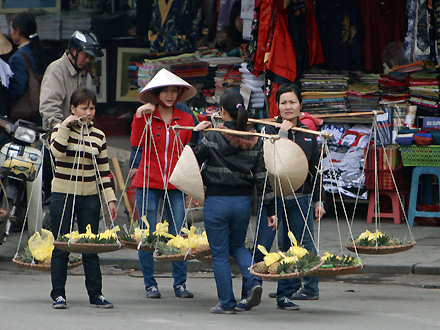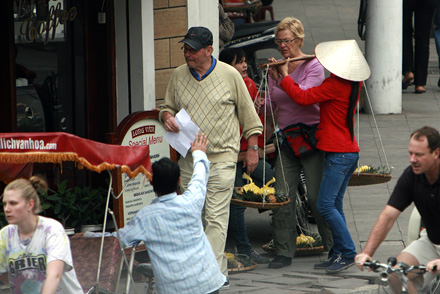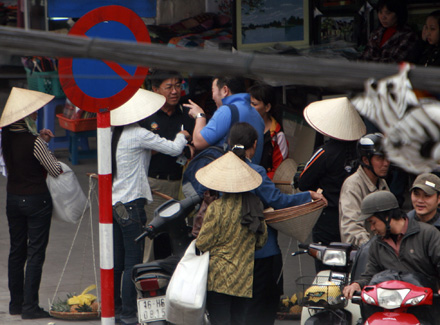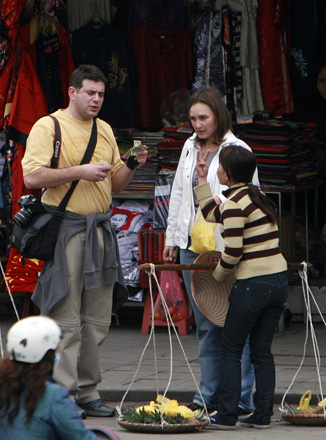TẠI SAO TỚI NÔNG NỖI NÀY?
PHẢI CHẮNG VÌ ĐƯỜNG LỐI KHÔN VẶT, “MÁNH HOÁ”, DỐI TRÁ, BẤT LƯƠNG CỦA CHẾ ĐỘ CỘNG SẢN?
THẬT ĐÁNG BUỒN … BAO GIỜ DÂN TỘC VIỆT MỚI LẤY LẠI DANH DỰ, PHẨM GIÁ TRUNG THỰC CỔ TRUYỀN?
ĐỪNG ĐỂ QUÁ MUỘN.
Let me count the ways…
I Hate Vietnam’s Lies
I’m tired of being lied to. It’s as if the population has a compulsive lying habit.
I was lied to when I instructed a shuttle bus driver from the airport to transport us to a specific hotel (where a man jumps out of a building claiming this is the address I asked for, insisting that he’s full, but will take us to another one around the corner). I was lied to when picking up a spare backpack left at a Hanoi hotel, with the staff trying to extort US$30 from me for a few days of keeping it chained to a desk in the corner of their lobby—we walked off without paying.
I’m constantly being lied to for stupid, simple, insignificant stuff as well. Like when I was purchasing some rather interesting cutout/popup greeting cards from a tiny store outside the tourist bubble. Tatiana asked how they were made, and the woman motioned that she made them herself with a scalpel. This was a total fabrication—I could see the bloody burn marks left from a laser that created the obviously mass-produced cards. I suppose she put that barcode sticker on the back of the card as well, huh?
Liars. So many damn liars.
I Hate Vietnam’s Dual Pricing
Although common in many countries, alternate pricing for foreigners is visible and in your face in Vietnam. The same boat ride that a tourist pays 100,000 dong for, finds your Vietnamese citizen neighbor paying 80,000d. I might haggle for a piece of fruit, but my ending price is still twice that of the local buying it next to me, because the vendor inflated the initial price 400%.
Most foreigners are seen as targets of opportunity. According to Nguyen Huu Viet, an official from the Tourism Department of Hanoi, overcharging foreign tourists is not necessarily a kind of fraud, but part of the “culture”.
An excerpt from an article entitled ‘The price isn’t quite right‘:
“American and Russian tourists are very generous but the most generous customers are from Japan, they hardly bargain at all,” says Thu Huong, who works in a small souvenir shop in the Old Quarter. “Even with a price 10-times the going rate, a Japanese customer might consider it cheap. But Italian or German tourists would just take a look and smile.”
The more naive of these tourists are called “ga beo” (fatty chicken), a slang term for those that jump at the price of $100 for a fake $10-Rolex watch from China or $40 for a $5-dollar-string of artificial pearls.
“To be honest I don’t really care about the souvenir shops or fruit sellers trying to get a bit more cash out of a foreigner, haggling for goods is part of the game,” says Daniel Lewenstein, an American lawyer living in Vietnam on and off for 10 years. “But it’s really annoying when there’s a set price and people try to chance their arm anyway, like the last time I arrived at Noi Bai airport the taxi driver tried to charge me VND280,000 for a trip to town even though it said VND150,000 on the sign!”
I Hate Vietnam’s Noise
It seems like this country has developed or enhanced every known way to pollute the environment with noise. The decibel level reaches a point on the street where I need to put ear plugs in because my ears are “eeeeeeeeeeeeing” by the time I get back inside the hotel.
Hundreds of thousands of muffler-less vehicles belch sound as they zoom through the streets. Horns are repeatedly honked by every motorist, on average, every five to seven seconds. They honk when passing someone; they honk when turning; they honk when pissed; they honk when happy; they honk when people aren’t moving fast enough; they honk whey they’re driving the wrong direction, against traffic on a one-way street; they honk to show off their custom horn; and they honk because everyone else is honking next to them. I watch and listen as some just keep the horn depressed as they drive along the avenues. In Hanoi, not a moment passes in the day when you don’t hear the sound of a horn—inside your hotel room, or not.
Socialist megaphones are installed in Hanoi that, several times daily, force tourists and residents alike to plug their ears to keep them from bleeding. The volume that emits from these hour-long news, weather, music, and advertisement announcements is actually so loud that it drowns out the honking. It’s that loud.
Having a street-facing hotel room in Vietnam is one of the last things you really want in the country, especially when you have one of these microphone attached to the building, jarring you awake at 7:00 in the morning with the amplified sound of their ugly language.
Between the vehicles, the constant construction, the language, and the karaoke bars, I find myself envying the deaf.
I Hate Vietnam’s Traffic and Pedestrian Woes
There are over 1.5 million motorcycles in Hanoi owned by city dwellers, plus over 400,000 motorcycles from outside the city—increasing at a rate of 14% each year. That’s a f**king lot of motorcycles, as evident by the hazardous conditions for pedestrians.
Every sidewalk is packed to the brim with vendors and households doubling their street-level floor as a business. This means that pedestrians are forced to walk in the street. The feeling of wind that rushes past you as you’re nearly clipped by a speeding motorbike or auto is at all times constant.
There are few crosswalks in a city that actually really needs them. Even when present, it only mitigates the risk of getting struck on the street by a vehicle slightly, as you’ll never get a green walk signal without vehicles turning right onto an adjoining street, or left from a green left-turn light.
The process of crossing a street saturated with traffic and no traffic control is simply to take the “Indiana Jones jump from the Lion’s Head Leap of Faith” approach. Think of the traffic like a raging river, and you as a slowly moving stone—the traffic will part, so long as you don’t stop or run.
This process scares the living daylights of Tatiana, who fears for the safety of the child in her belly every time she ventures outside the hotel. Going anywhere is a major ordeal, as the thought of being struck by an errant motorbike and the subsequent consequences on our unborn son would be devastating. I always hold her hand and stand between her and the direction of the oncoming traffic—the padded human shield technique. I can’t blame her, but she still has the habit of wanting to stop when it looks like she’s about to get hit, which is the wrong thing to do. That’s going to get us all killed. Do not stop. Do not run. Those are the rules. You must let go of your fear like you’re about to jump out of an airplane, and trust that all will be well.
I Hate Vietnam’s Skinny Buildings
Climbing countless flights of stairs because the Vietnamese like to build their hotels at the width of a single room pisses me off. I’ve had to pass on quality rooms because they’re on the eighth floor and a near seven-month pregnant Tatiana can’t walk past the third floor without getting winded.
I Hate the way the Vietnamese Obstruct Storefronts
The cultural habit of parking motorbikes in such a way that every square centimeter of space in front of a store or restaurant I want to enter drives me nuts. The lack of thinking and courtesy towards others that is embodied on the roads manifests itself in parking protocol: Push and shove your way into any available open space and claim success.
I realize there’s no space for anyone or anything in this unholy place of traffic misery, but not everyone is a 43-kilo twig-shaped-ninja that can maneuver through these things—just look to Tatiana’s massive belly to understand how it prohibits her movement here.

I knew better than to believe I’d actually get something resembling lobster for US$3, but we were in the middle of the Gulf of Tokin, and seafood was the most prevalent item on the menu. Just maybe I’ll come out Aces, I thought.
What was tossed on my plate was one of the most visually revolting animals I’ve ever seen. These sweet and sour covered mutants of the sea looked like the evil offspring of a prawn and lobster. I didn’t dare look as Tatiana extracted what little meat was actually contained within their hideous exoskeletons.
I Hate Vietnam’s Chairs, Cockroaches, and Cholera
I know the people are small, but why am I so often forced to eat while sitting on a stool designed for a four-year-old?
Cockroaches on the street. Cockroaches in my transport. Cockroaches found cooked in my food. Just plain foul. It’s no wonder this country still has cholera issues:
HANOI (Reuters) – A cholera outbreak in northern Vietnam has affected more than 200 people.
The ruling Communist Party’s daily Nhan Dan (People) quoted Health Minister Nguyen Quoc Trieu as saying over 1,600 people have suffered vomiting acute diarrhea, 202 of whom tested positive for cholera bacteria since Oct. 23. The reports did not say whether anyone had died in an epidemic of acute diarrhea in 13 provinces and cities out of 64 in Vietnam, where the last widespread cholera outbreak was in 2004.
I Hate Vietnam’s Taxi Drivers
I’m not an idiot with taxis. My doors are always locked, my guard is always up, and I’m constantly monitoring where we’re going—making a little map in my head or ensuring that the driver is generally following a path that I’ve memorized by looking at the layout of the city ahead of time. When people don’t pay attention, they get cheated, robbed, or worse. Taxi drivers are, the world round, the scum of the Earth. Way below that of lawyers.
In Vietnam, it’s really to the point where we consistently expect the worst out of every taxi ride. This is a country known for rigged meters (that count faster than they should) and shady drivers. Hell, the people try everything they can to screw you over on the streets, so there’s no reason to think they won’t do it in a cab.
I recall how one taxi driver took us for an excessive 8 minute/two kilometer ride around a popular lake in the Old Quarter instead of driving directly to our destination. I called him out on it halfway around, and watched him try to claim that the flow of traffic didn’t allow for it (when I knew there were several opportunities for him to do so). Others would drive around and pretend to not know where they were going (or they were really just that stupid); while two others absolutely refused to stop the cab when we no longer wanted to deal with idiotic behavior.
When we knew the fair should be about 18,000 dong and the meter, and at our destination it said 25,000d, 48,000d, or 55,000d, we’d refuse to pay the full fair. One three or more occasions Tatiana and I threw a 20,000d note at a driver and walked away. One wouldn’t accept it and came chasing after us on foot, only to walk away with it after losing face.
We tried calling both expensive inexpensive cab companies to pick us up versus flagging them down on the street, but it yielded the same mixed results. There’s absolutely no consistently to the companies or their drivers. The best policy is to just not put up with their shit and pay what you think is fair, regardless of what that little (rigged) box says on the dashboard.
I Hate the Cultural Insensitivity of the Vietnamese People
There is a real culture clash happening with travelers and locals in this country. Tatiana expresses to me how much she loathes it when people touch her—a sentiment that I share. She understands that it’s a part of their culture to grab arms or elbows on the street to try to get someone do buy something or do an action, but it’s a line that she doesn’t like to be crossed.
“I understand why they do it, it’s a part of their culture, but why can’t they understand that it’s offensive in mine to do it?”
I personally won’t tolerate it from beggars and pith helmet wearing men on the street, regardless. I aggressively clapped my hands a few centimeters away one man’s face to illustrate such a point—instead of slapping him, like Tatiana did one night on a separate incident.
Tatiana also hates how shop staff will follow you around so close “that you can feel their breath on your neck.”
The Unhappy Traveler
Mánh “Hà Nội”
 Nhóm phụ nữ khoảng 8 người với bình phong là những người làm nghề gồng gánh, buôn bán trên phố, họ trắng trợn ép du khách để lấy tiền bằng các thủ đoạn: ấn quang gánh vào vai du khách, ép chụp ảnh rồi đòi tiền “bo”, chèo kéo khách mua hàng giá cao…
Nhóm phụ nữ khoảng 8 người với bình phong là những người làm nghề gồng gánh, buôn bán trên phố, họ trắng trợn ép du khách để lấy tiền bằng các thủ đoạn: ấn quang gánh vào vai du khách, ép chụp ảnh rồi đòi tiền “bo”, chèo kéo khách mua hàng giá cao…
Nhóm phụ nữ trong vai người buôn bán tụ tập chờ “con mồi”
Ngày nào cũng vậy, khoảng 9h30 sáng, nhóm phụ nữ này bắt đầu tụ tập tại đầu phố Cầu Gỗ. Sau đó, họ chuẩn bị vài túi dứa xanh gọt sẵn, mấy quả chuối để lỏng chỏng trên đôi quang gánh và bắt đầu một “ngày làm việc”. Ai cũng đi đôi giầy ba ta buộc chặt chân gọn gàng. Khi “hóa trang” xong, nhìn hình thức bề ngoài, họ không khác gì mấy người buôn bán gồng gánh quê chân chất, nhưng thực chất chỉ nhăm nhe rình rập “chộp” những vị nước ngoài đang còn bỡ ngỡ để moi tiền.
 Những phụ nữ này thường đứng “săn” khách ở vị trí có đông người nước ngoài qua lại, mắt láo liên nhìn các hướng để xác định “con mồi”. Khi “con mồi” xuất hiện, họ bắt đầu tiếp cận bằng vẻ niềm nở, vồn vã để tạo sự thân thiện với du khách, sau đó vội vàng ấn đôi quang gánh vào vai mời chụp ảnh, tiếp theo là các hành vi úp nón lên đầu khách, lấy túi dứa dúi vào tay họ… Lúc này du khách vẫn chưa biết được ý đồ của mấy “bà bán rong”, chỉ khi bị đòi đến 5 đô la một túi dứa, hoặc 50-100 nghìn đồng, thậm chí nhiều hơn cho việc “thuê quang gánh chụp ảnh” hay “mua hàng” thì khách mới té ngửa. Sau đó lợi dụng sự bất đồng về ngôn ngữ, họ dùng số đông để áp đảo và thường thắng thế trong lúc đôi co với khách nước ngoài.
Những phụ nữ này thường đứng “săn” khách ở vị trí có đông người nước ngoài qua lại, mắt láo liên nhìn các hướng để xác định “con mồi”. Khi “con mồi” xuất hiện, họ bắt đầu tiếp cận bằng vẻ niềm nở, vồn vã để tạo sự thân thiện với du khách, sau đó vội vàng ấn đôi quang gánh vào vai mời chụp ảnh, tiếp theo là các hành vi úp nón lên đầu khách, lấy túi dứa dúi vào tay họ… Lúc này du khách vẫn chưa biết được ý đồ của mấy “bà bán rong”, chỉ khi bị đòi đến 5 đô la một túi dứa, hoặc 50-100 nghìn đồng, thậm chí nhiều hơn cho việc “thuê quang gánh chụp ảnh” hay “mua hàng” thì khách mới té ngửa. Sau đó lợi dụng sự bất đồng về ngôn ngữ, họ dùng số đông để áp đảo và thường thắng thế trong lúc đôi co với khách nước ngoài.
Một thủ đoạn khác cũng rất trắng trợn, họ chuẩn bị sẵn nhiều tiền lẻ, khi khách trót trả tiền bằng đô la hay tiền mệnh giá lớn, họ moi ra một vốc tiền lẻ dúi vào tay khách rồi… chuồn.
Kết thúc màn “thuê quang gánh” và “bán hàng” như vậy, bao giờ cũng là cái lắc đầu, nhún vai ngán ngẩm chấp nhận việc đã rồi. Cứ thế rất nhiều du khách đã sa bẫy nhóm phụ nữ này, để rồi hằn lại một ấn tượng rất xấu về thủ đô Hà Nội, nơi đang chuẩn bị bước sang tuổi… 1000.
Trong khi chính quyền và nhân dân Thủ đô đang nỗ lực quảng bá với bạn bè quốc tế về Hà Nội nghìn năm thì cảnh tượng những người đội lốt hàng rong lừa đảo du khách diễn ra một cách công khai tại một không gian văn hóa tiêu biểu giữa thủ đô là điều không thể chấp nhận được.
 Phóng viên Dân trí đã mất gần một tuần “theo” nhóm phụ nữ này để ghi lại những hình ảnh không đẹp dưới đây: Lao tới ấn quang gánh vào du khách. Những hành động thiếu văn hóa khiến du khách bất bình. Nhưng không vì thế mà họ dễ dàng buông tha. Kẻ trước, người sau úp nón và ấn quang gánh vào vai du khách và … đòi tiền
Phóng viên Dân trí đã mất gần một tuần “theo” nhóm phụ nữ này để ghi lại những hình ảnh không đẹp dưới đây: Lao tới ấn quang gánh vào du khách. Những hành động thiếu văn hóa khiến du khách bất bình. Nhưng không vì thế mà họ dễ dàng buông tha. Kẻ trước, người sau úp nón và ấn quang gánh vào vai du khách và … đòi tiền
Bị “hàng rong” quây thô bạo, nhiều du khách không hiểu chuyện gì đã xảy ra với mình. Nếu một người ép được du khách thì cả nhóm lao vào để dở nhiều thủ đoạn khác nhằm lấy tiền. Nhóm “hàng rong” này thường nhắm đến những du khách hiền lành đi đơn lẻ. Hoặc đôi trai gái.
Nếu du khách bất cẩn thì sẽ bị nhóm “hàng rong” móc tiền rất tinh vi và điệu nghệ. Khi chưa hay, du khách vui vẻ vì lầm tưởng đây là những người bán hàng tốt bụng
 Rồi ngã ngửa khi bị đòi tiền. Dưới đây là trọn màn lừa đảo. Chèo kéo và chụp nón. Rồi mồm năm miệng mười để dồn du khách. Từ 5 đến 7 đô la cho vài ba quả chuối hoặc vài miếng dứa gọt sẵn. Bị đòi tiền giá cắt cổ khách đã phản ứng lại nhưng đành chấp nhận.
Rồi ngã ngửa khi bị đòi tiền. Dưới đây là trọn màn lừa đảo. Chèo kéo và chụp nón. Rồi mồm năm miệng mười để dồn du khách. Từ 5 đến 7 đô la cho vài ba quả chuối hoặc vài miếng dứa gọt sẵn. Bị đòi tiền giá cắt cổ khách đã phản ứng lại nhưng đành chấp nhận.
KAVITI
TẠI SAO TỚI NÔNG NỖI NÀY?
PHẢI CHẮNG VÌ ĐƯỜNG LỐI KHÔN VẶT, “MÁNH HOÁ”, DỐI TRÁ, BẤT LƯƠNG CỦA CHẾ ĐỘ CỘNG SẢN?
THẬT ĐÁNG BUỒN … BAO GIỜ DÂN TỘC VIỆT MỚI LẤY LẠI DANH DỰ, PHẨM GIÁ TRUNG THỰC CỔ TRUYỀN?
ĐỪNG ĐỂ QUÁ MUỘN.















































